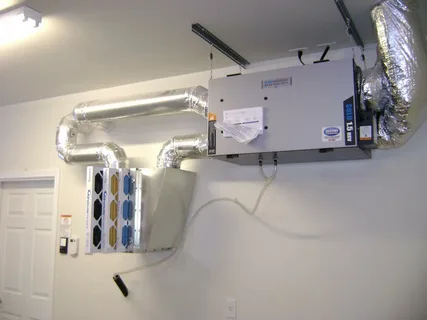When it comes to maintaining a healthy and comfortable home, one often overlooked aspect is indoor air quality. Many homeowners are unaware that stale or polluted air can seriously affect their health and well-being. Enter the Whole House Air Exchanger—a game-changing solution designed to enhance airflow while ensuring your living environment remains fresh and clean. Imagine breathing in crisp, filtered air daily, free from allergens and harmful particles. A whole-house air exchanger helps you achieve that by efficiently replacing old indoor air with fresh outdoor oxygen.
Understanding the Importance of Indoor Air Quality
Indoor air quality plays a crucial role in our overall health and well-being. Many people spend up to 90% of their time indoors, often unaware of the pollutants lurking in their environment. Common allergens such as dust mites, mould spores, and pet dander can accumulate over time. These irritants may lead to respiratory issues or exacerbate existing conditions like asthma. Furthermore, household products’ volatile organic compounds (VOCs) can contribute to poor air quality. When used regularly, cleaners and paints release harmful gases that linger in our air.
A whole-house air exchanger helps combat these problems by continuously refreshing indoor air with fresh outdoor sources. This system reduces contaminants while maintaining comfortable humidity throughout your home for healthier living spaces. Prioritizing indoor air quality is essential for ensuring a safe and pleasant atmosphere for you and your family.
Professional Ventilation Installation for Healthier Indoor Air Quality
Professional ventilation installation is pivotal for achieving optimal indoor air quality. When done correctly, it ensures that fresh air circulates throughout your home while expelling stale air. Experienced technicians assess your space and recommend the best system tailored to your needs. They consider room size, layout, and existing HVAC systems. Proper installation means fewer leaks and better airflow management. This precision can dramatically reduce allergens, odours, and environmental pollutants.
Moreover, professionals can integrate advanced controls into the system for enhanced performance. With smart technology options available today, you can even monitor air quality remotely. Investing in professional services improves comfort and supports long-term health benefits by promoting cleaner indoor environments. Choose wisely; a well-installed whole-house air exchanger makes all the difference.
Key Features to Consider When Choosing an Air Exchanger
When selecting a whole-house air exchanger, focus on the essential features that suit your needs. Start with the capacity of the unit. It should match the size of your home to ensure proper airflow. Look for models with adjustable fan speeds. This allows you to customize ventilation based on current weather conditions or specific indoor activities, improving comfort and efficiency.
Another key aspect is the ease of installation. Choose an air exchanger designed for straightforward setup, reducing both the time and costs associated with professional help. Additionally, consider how user-friendly the controls are. Intuitive interfaces make it easier to manage settings without frustration. Don’t overlook compatibility with existing HVAC systems, too. A seamless integration can enhance overall performance while minimizing energy consumption during operation.
Energy Efficiency and Cost Savings
Energy efficiency is a crucial factor when selecting a whole-house air exchanger. A system with energy-saving features can significantly reduce your utility bills over time. Look for models that have high-efficiency ratings, as these will consume less power while still maintaining optimal airflow.
Advanced technology options like variable-speed motors can adjust the fan speed based on indoor and outdoor conditions, providing just the right amount of ventilation without wasting energy. Cost savings extend beyond monthly bills. An efficient air exchanger helps maintain an even temperature throughout your home, reducing strain on your heating and cooling systems. This not only prolongs their lifespan but also minimizes costly repairs.
Indoor Air Quality
Air exchangers are designed to improve indoor air quality by removing stale, polluted air and replacing it with fresh, clean air from outside. This is especially important for tightly sealed homes that lack natural ventilation. A high-quality whole-house air exchanger can significantly reduce contaminants such as dust, pollen, and mould spores in your home. Look for models with HEPA or MERV filters, which capture even smaller particles and provide superior filtration.
Temperature Control
A whole-house air exchanger helps maintain a consistent temperature throughout your home by exchanging warm or cool air indoors and outdoors. This can be particularly beneficial during extreme weather conditions when you want to keep your home comfortable without relying solely on your heating or cooling system. Some models also have built-in humidity controls to regulate moisture levels, preventing excessive dryness in winter or humidity in summer.
Ease of Use and Maintenance
A good whole-house air exchanger should be easy to operate and maintain. Look for models with intuitive controls that allow you to adjust settings quickly. Regular maintenance is also crucial for optimal performance, so choose a system with easily accessible filters that can be replaced or cleaned regularly.
Noise Levels and Maintenance
When choosing a Whole-House Air Exchanger, noise levels can significantly impact your comfort. Look for models that operate quietly to ensure they don’t disturb your daily activities or sleep. Pay attention to decibel ratings provided by manufacturers. Lower ratings generally mean quieter operation. Some advanced systems come with sound-dampening features designed specifically to minimize noise.
Maintenance is another critical aspect. Regular upkeep ensures the unit’s efficiency and longevity. Check filters often, as clogged ones can lead to increased noise and reduced airflow. Ease of access for maintenance tasks makes a big difference, too. Models designed for simple filter replacement will save you time and effort in the long run. Keeping an eye on noise levels and maintenance needs helps guarantee a more pleasant indoor environment for years ahead.
Filtration System
A robust filtration system is essential when choosing a Whole-House Air Exchanger. It plays a significant role in maintaining healthy indoor air quality. Look for models equipped with high-efficiency particulate air (HEPA) filters. These can capture tiny particles, including dust, allergens, and even some bacteria. Clean air contributes to better health and comfort for everyone in your home.
Some systems also feature activated carbon filters. They help remove odors and harmful gases from the air, making this added layer of protection a noticeable difference. Regular maintenance of the filtration system is crucial, too. Ensure you replace or clean your filters as the manufacturer recommends to keep airflow efficient and effective. Investing in an advanced filtration system ensures you’re not just exchanging stale air but actively improving it daily.
Optimized Exhaust Ventilation Systems for Effective Airflow Management
An optimized exhaust ventilation system is crucial in maintaining indoor air quality. It effectively removes stale, contaminated air, allowing fresh outdoor air. These systems are designed to manage airflow smartly. They assess the interior environment and adjust accordingly, preventing excess humidity and minimizing pollutants. A well-functioning exhaust system reduces allergens and irritants, creating a healthier living space.
Flexible ductwork can enhance performance by facilitating proper air movement throughout the home. This design helps eliminate dead zones where air might stagnate. Integrating these solutions with your Whole-House Air Exchanger will provide balanced ventilation. The result? Continuous circulation of clean, breathable air without compromising your home’s energy efficiency or comfort levels. Here are some key features of an optimized exhaust-ventilation system for effective airflow management:
Variable Speed Fans
These fans adjust their speed according to indoor air quality and occupancy levels, ensuring proper air exchange rates without wasting energy.
Automatic Dampers
These dampers automatically open or close based on the need for ventilation, preventing over-ventilation and unnecessary energy loss.
Programmable Controls
These controls allow you to set specific ventilation schedules and adjust them as needed, making it easier to manage indoor air quality.
High-Efficiency Filtration
Incorporating high-efficiency filters in your exhaust system can effectively remove pollutants, allergens, and other harmful particles from the air.
Heat Recovery Systems
These systems recover heat from the exhaust air and preheat incoming fresh outdoor air, reducing energy consumption and maintaining comfortable temperatures inside the home.
Regular Maintenance
Proper maintenance of your exhaust ventilation system is crucial to ensure optimal performance and longevity. Regular filter replacements, duct cleaning, and fan motor checks should be included in
Heat and Moisture Recovery
Heat and moisture recovery are key when selecting a whole-house air exchanger. This technology efficiently transfers heat from outgoing stale air to incoming fresh air, reducing energy costs while maintaining comfort. During winter months, it helps retain warmth inside your home. In summer, it can help cool down the incoming hot air. This balance creates an optimal indoor climate year-round.
Also, managing humidity levels is crucial in preventing mould growth and improving overall health. A reliable system will remove excess moisture without sacrificing energy efficiency. Investing in an air exchanger with effective heat and moisture recovery capabilities enhances your home’s ventilation without putting extra strain on heating or cooling systems. It’s an eco-friendly choice that contributes significantly to sustainable living practices while keeping indoor environments healthy and comfortable.
Programmable Controls And Smart Technology
Programmable controls and smart technology are game-changers in whole-house air exchangers. These features allow homeowners to customize their ventilation system according to their needs. Imagine being able to set your air exchanger to run at certain times throughout the day or adjust settings from your smartphone while you’re away. This convenience not only boosts comfort but also enhances energy efficiency. Smart technology often comes with sensors that monitor indoor air quality. They can detect changes in humidity and pollutant levels, automatically adjusting airflow.
Integration with home automation systems takes it further, allowing seamless coordination with other devices like thermostats and security systems. With these advanced features, managing your home’s air quality becomes effortless and efficient, ensuring a healthier environment for you and your family.
Installation and Professional Assistance
Installing a whole-house air exchanger is not a DIY project. It requires knowledge and expertise to ensure optimal performance. Hiring professionals can save you time and headaches. They understand the intricacies of your home’s ventilation system, which is crucial for achieving maximum efficiency. A trained technician will evaluate your space, considering factors like size and layout. They’ll recommend the best placement for your unit, ensuring effective airflow throughout your home.
Moreover, professional installation often comes with warranties or guarantees on work performed, adding an extra layer of security to your investment. Remember that proper setup directly impacts energy efficiency and indoor air quality. Relying on experts ensures that everything runs smoothly from day one, giving you peace of mind as you enjoy cleaner air in your living space.
Conclusion
Choosing the right Whole House Air Exchanger is vital for maintaining a healthy indoor environment. You can ensure that your home benefits from optimal air quality by considering essential features like energy efficiency, noise levels, filtration systems, and smart technology. Investing in professional installation will further enhance performance and longevity. You’ll enjoy better airflow management throughout your living spaces with an effective exhaust-ventilation system. Take the time to research and evaluate options that fit your specific needs.
FAQs
What is a Whole House Air Exchanger, and Why is it Important?
A Whole House Air Exchanger is a ventilation system designed to improve indoor air quality by exchanging stale indoor air with fresh outdoor air. It is essential for maintaining healthy humidity levels, reducing airborne pollutants, and enhancing overall comfort. Ideal for homes with poor natural ventilation or located in areas with extreme weather, it ensures balanced airflow throughout the house.
What Efficiency Features Should I Look For?
Look for energy-efficient models that include heat or energy recovery ventilators (HRVs/ERVs). These systems transfer heat or coolness from outgoing air to incoming air, reducing energy costs while maintaining a comfortable indoor climate. High-efficiency filters are also crucial to capture allergens, dust, and other particulates.
How Does Noise Level Impact My Choice?
Quiet operation is a key feature to consider, especially for systems installed in living spaces or bedrooms. Check the product’s noise rating, measured in sones or decibels, to ensure it operates unobtrusively. Low-noise models are ideal for creating a peaceful home environment.
Are Smart Features and Controls Necessary?
Modern air exchangers often include smart features like programmable timers, humidity sensors, and smartphone connectivity for remote operation. These enhance convenience and allow you to customize ventilation based on your schedule and the home’s specific needs, improving efficiency and comfort.



